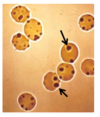Lecture 1- Oxidative stress Flashcards
Oxidative stress and disease
Cellular damage caused by ROS and RNS (reactive nitrogen species) is a significant component in a wide range of disease states.
which diseases are associated with oxidative stress
- CVD
- MS
- Alzheimers
- RA
- Crohns
- COPD
- Ischaemia/reperfusion injury
- cancer
- pancreatitis
- parkinsons

reactive oxygen species
Umbrella term which describes all types of free radicals (counts as reactive nitrogen species too )
free radicals
A free radical is an atom or molecule, that contains one or more unpaired electrons and is capable of independent (free) existence

why are free radicals bad for you
- Free radicals are very reactive and tend to acquire electrons from other atoms, molecules or ions
- Reaction of a radical with another molecule typically generates a second radical thereby propagating damage
A superscript dot used to denote
free radical (e.g. OH)
name 4 reactive oxygen species
oxygen
superoxide
hydrogen peroxide
hydroxyl radical

Oxygen
itself is a free radical (2 unpaired electrons in two diff energy levels-relatively stable)
When oxygen gains an electron it becomes
superoxide
Superoxide
- produced by adding electron to moelcular oxygen
- important sourc eof ROS
- Can incorporate with hydrogen to form hydrogen peroxide - damaging

hydrogen peroxide is
not a free radical but can react with Fe2+ to produce free radicals –> readily diffusible

hydroxyl radical
most reactive and damaging free radical –> reacts with anything

reactive nitrogen species
Superoxide can also combine with nitric oxide to produce peroxynitrite (powerful oxidant that damages cells- not a ROS)

peroxynitrite
is not itself a free radical–> powerful oxidatn that can damage cells
two types of DNA damage caused by ROS
- ROS reacts with base
- ROS reacts with sugar (ribose or deoxyribose)
- ROS reacts with base
- Modified base can lead to mispairing and mutation
ROS reacts with sugar (ribose or deoxyribose)
can cause strand break and mutation on repair
what can be used as a measurment of oxidativve damage in cells
8-oxo-dG

how can ROS cause cancer

ROS damage to lipids
- Free radical extracts hydrogen atom from polyunsaturated fatty acid in membrane lipid
- Lipid radical formed which can react with oxygen to form lipid peroxyl radical
- Chain reaction formed as lipid peroxyl radical extracts hydrogen from nearby fatty acid
- Hydrophobic environment of bilayer disrupted and membrane integrity fails

ROS damage to protein
Can damage the backbone or sidechain
-
Leading to either:
- Loss of function
- Protein degradation
- Gain of function

disulphide bonds are formed between
thiol groups of cysteine residues

ROS and disulphide bone formation
Inappropriate bond formation can occur if… ROS takes electrons from cysteines causing misfolding, crosslinking and disruption of function e.g. enzymes















